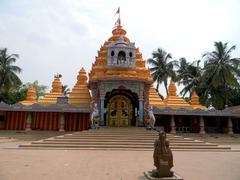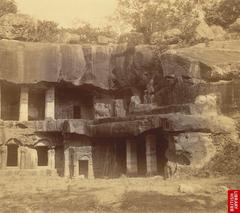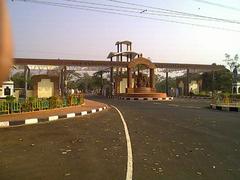Baitala Deula Visiting Hours, Tickets, and Complete Guide to Bhubaneswar’s Historic Temple
Date: 14/06/2025
Introduction
Baitala Deula—also known as Vaitala Deula or Tini Mundia Mandira—is a standout among Bhubaneswar’s ancient temples, celebrated for its striking Khakhara architectural style and deep Tantric associations. Built in the 8th century CE, it is dedicated to Goddess Chamunda, a fierce form of the Divine Mother, and remains an active locus for religious observance and cultural exploration. This guide presents everything you need to know, from historical context and architectural marvels to visiting hours, practical tips, and nearby attractions, enabling travelers and devotees to experience the temple’s profound legacy to the fullest (Times of India; Orissa Guide).
Table of Contents
- Historical Significance and Origins
- Architectural and Artistic Features
- Religious and Tantric Importance
- Visitor Information: Hours, Tickets, Accessibility
- Dress Code and Etiquette
- Festivals, Rituals, and Cultural Observances
- Facilities, Amenities, and Safety
- Nearby Attractions
- Frequently Asked Questions (FAQ)
- Travel Tips
- Visuals, Media, and Further Resources
- Conclusion and Visitor Recommendations
- Sources and Official Links
Historical Significance and Origins
Baitala Deula stands as a testament to early medieval Odisha’s syncretic spirituality, blending Shaivism, Shaktism, and Tantric practices. Erected in the 8th century CE, the temple’s name derives from the Odia word for “spirit” or “ghost,” signifying its historical role as a Tantric pitha (seat of esoteric rites). Its alternative name, “Tini Mundia Mandira,” refers to the three-spired (mundia) superstructure representing the goddess’s triune aspects (Tripoto). The temple’s continued ritual use and architectural innovations make it a vital piece of Bhubaneswar’s spiritual and artistic heritage.
Architectural and Artistic Features
Khakhara Order and Sanctuary Tower
Baitala Deula is renowned for its Khakhara style—defined by a semi-cylindrical, barrel-vaulted roof that distinguishes it from the more common curvilinear spires of Odisha’s Rekha Deula temples. This unique sanctuary tower, oblong in plan, echoes Buddhist chaitya halls and South Indian Dravidian gopurams, highlighting a dynamic cross-cultural influence (Navrang India; Orissa Guide). The adjoining jagamohana (assembly hall) is rectangular, enhancing the temple’s distinctive profile.
Facade and Chaitya Windows
Two prominent chaitya (arched) windows dominate the facade:
- The lower window features Surya (the Sun God) flanked by Usha and Pratyusha, with Aruna driving a seven-horse chariot—a scene reflecting classical Hindu iconography.
- The upper window portrays a ten-armed Nataraja (Shiva as cosmic dancer), underscoring the temple’s Shaivite connections (Navrang India).
Intricate Carvings and Iconography
The temple’s external walls are adorned with:
- Fearsome images of Chamunda, seated on a corpse, garlanded with skulls, and surrounded by Tantric symbols.
- Scenes depicting hunting, processions, and occasional mithuna (erotic) couples, emblematic of creative and regenerative forces.
- Carvings of Shiva, Parvati, Surya, Nataraja, and the Matrikas, reflecting the temple’s role as a vibrant center of mythological storytelling (Orissa Guide).
Syncretic and Tantric Elements
A stone post in front of the jagamohana is carved with Buddha-like figures in the Dharma-Chakra-Pravartana mudra, reflecting the temple’s syncretic absorption of Buddhist motifs (Navrang India). The sanctum’s macabre imagery and tantric sculptures reinforce Baitala Deula’s legacy as a seat of esoteric rites.
Construction Materials and Techniques
Built from locally quarried sandstone using advanced mortise-and-tenon joinery, the temple’s precise engineering and enduring craftsmanship have enabled it to withstand centuries of natural wear (Orissa Guide).
Religious and Tantric Importance
Baitala Deula is dedicated to Chamunda (Kapalini), a terrifying aspect of Shakti central to Tantric worship. Historically frequented by Kapalika and Tantric practitioners, the temple’s rituals centered on the balance of destructive and creative energies. Although many esoteric rites are now discontinued, the temple’s art and architecture preserve this mystical heritage (Tripoto).
The temple also features depictions of Lakulisha, the Shaivite yogi, and his disciples, further emphasizing its importance in the evolution of Tantric and Shaivite traditions in eastern India.
Visitor Information: Hours, Tickets, Accessibility
- Opening Hours: Daily, 6:00 AM – 8:00 PM (Times of India; Tripoto). Note: Some sources mention 7:00 AM or 8:00 AM as the opening time, but most visitors can access the temple from early morning.
- Entry Fee: Free for all visitors; voluntary donations are appreciated for temple maintenance (Orissa Guide).
- Location: Baitala Deula Road, Old Town, Bhubaneswar, Odisha 751002.
- How to Reach:
- By Air: Biju Patnaik International Airport (approx. 5 km)
- By Rail: Bhubaneswar Railway Station (approx. 4 km)
- By Road: Auto-rickshaws, taxis, and city buses are available from major transit points.
- Accessibility: The temple complex has uneven stone pathways and steps; currently, there are no wheelchair ramps, so visitors with mobility challenges are advised to bring assistance.
Dress Code and Etiquette
- Attire: Modest dress covering shoulders and knees is required. Remove shoes before entering temple interiors.
- Behavior: Maintain decorum; avoid loud conversations and touching idols.
- Photography: Permitted in outer areas; seek permission for photography inside the sanctum or during rituals. Flash is discouraged.
Festivals, Rituals, and Cultural Observances
- Daily Pujas: Conducted morning and evening with offerings of flowers (especially red hibiscus), incense, and lamps.
- Major Festivals:
- Navaratri (Sept–Oct): Special Tantric rituals, temple decorated with lamps, surge in devotees.
- Kali Puja (Oct–Nov): Midnight ceremonies celebrating the goddess’s fierce aspect.
- Chaitra Parba (March–April): New Year rituals invoking health and prosperity.
During festivals, the temple is beautifully decorated and filled with devotional music and rituals, offering visitors a unique glimpse into Odisha’s living religious traditions.
Facilities, Amenities, and Safety
- Restrooms: Available nearby, but limited on-site facilities.
- Shops: Religious offerings and local snacks are sold at temple approach; eateries are within walking distance.
- Safety: The area is generally safe and well-patrolled. Emergency services are accessible within 2 km (Police: 100, Ambulance: 108).
Nearby Attractions
Baitala Deula’s central location allows visitors to explore several other historical gems:
- Lingaraj Temple: A 11th-century marvel, less than 1 km away.
- Mukteswara Temple: Famed for exquisite carvings, nearby.
- Rajarani Temple: Known for its sculptural artistry.
- Bindu Sagar Lake: A peaceful spot for reflection.
- Odisha State Museum: For an in-depth view of the region’s heritage.
Frequently Asked Questions (FAQ)
Q1: What are the visiting hours of Baitala Deula?
A1: Daily from 6:00 AM to 8:00 PM. Some sources cite 7:00 or 8:00 AM as opening; morning and evening are best for visiting.
Q2: Is there an entry fee?
A2: No, entry is free.
Q3: Is the temple wheelchair accessible?
A3: No, the temple has uneven stone paths and steps.
Q4: Are guided tours available?
A4: Local guides can be hired at the entrance for a fee; no official tours.
Q5: Can I take photographs inside?
A5: Photography is allowed in outer areas; inside, permission is required.
Travel Tips
- Best Season: October–March (pleasant weather and major festivals).
- Time of Day: Early morning or late afternoon for fewer crowds and good photography light.
- Footwear: Wear shoes that are easy to remove.
- Offerings: Red hibiscus flowers, coconuts, and sweets are customary.
- Cash: Carry small denominations for offerings and guide fees.
- Respect: Always follow local customs and participate respectfully if invited to rituals.
Visuals, Media, and Further Resources
- High-quality photographs of the temple’s architecture and carvings are available on official tourism websites.
- Interactive maps and visual guides can enrich your planning.
- Odisha Tourism Official Website
Conclusion and Visitor Recommendations
Baitala Deula encapsulates Odisha’s rich cultural, architectural, and spiritual legacy. Its distinctive Khakhara design, powerful Tantric iconography, and ongoing rituals make it an essential stop for history buffs, cultural travelers, and spiritual seekers. Plan your visit to coincide with major festivals for a deeper cultural experience. Remember to respect the active worship and unique traditions that make Baitala Deula one of Bhubaneswar’s most memorable landmarks.
Sources and Official Links
- Times of India: Exploring Baitala Deula
- Navrang India: Baitala Deula
- Orissa Guide: Baitala Deula
- Tripoto: Baitala Deula Visiting Guide
- GoSahin: Baitala Deula
- Odisha Tourism Official Website








